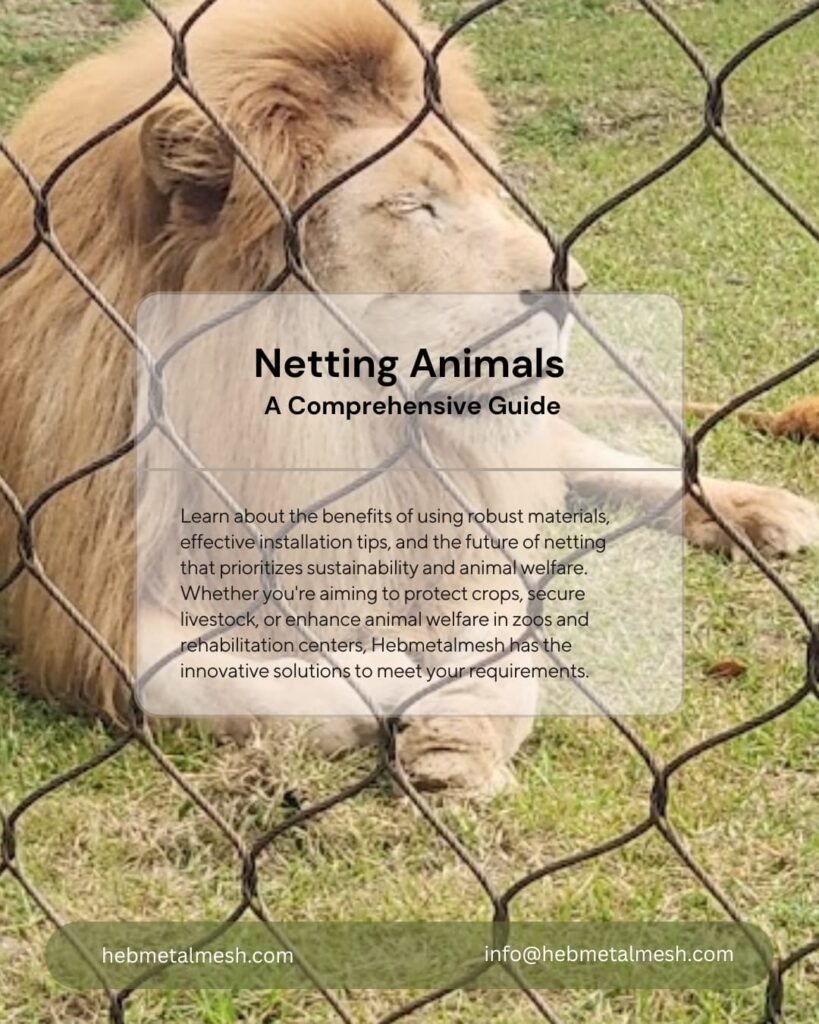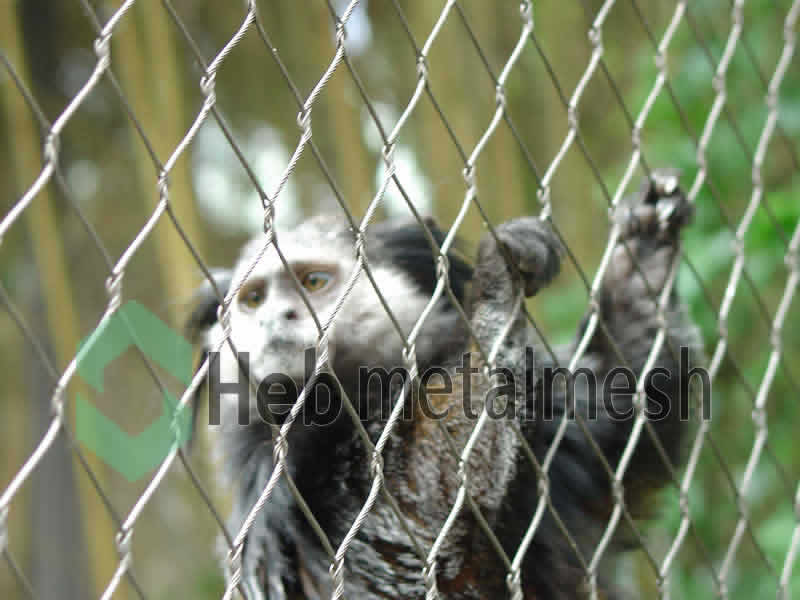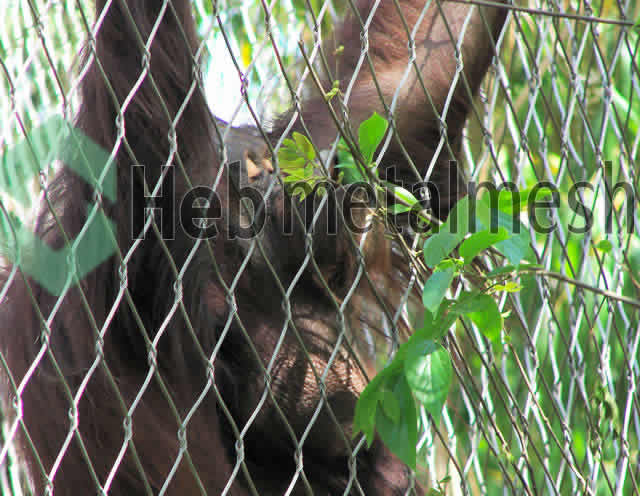Introduction to Hebmetalmesh and Netting Animals
Netting animals is an essential practice in both wildlife management and agricultural settings. It serves a myriad of purposes, including protecting crops from potential damage caused by wildlife, creating safe enclosures for animal husbandry, and ensuring the humane capture and release of various species. To achieve effective netting, the quality of materials used plays a critical role, and this is where Hebmetalmesh comes into the picture.
Hebmetalmesh is a prominent supplier specializing in high-quality netting solutions. With a commitment to sustainability and innovation, the company produces a range of products explicitly designed to meet the diverse needs of netting animals. Whether the application involves securing a pasture to keep livestock contained, or protecting sensitive areas from invasive species, Hebmetalmesh’s offerings are tailored to ensure durability and effectiveness.
The significance of utilizing robust materials for netting cannot be overstated. High-quality netting provides not only the necessary strength to withstand harsh environmental conditions but also the assurance of safety for both the animals and the surrounding ecosystem. Poorly constructed netting can lead to unintended harm, including injury to the animals involved or disruption of local wildlife. By investing in reliable netting solutions from reputable suppliers like Hebmetalmesh, users can have peace of mind knowing that they have made a responsible choice in protecting animals.
In this comprehensive guide, we will delve into the various products offered by Hebmetalmesh and explore the specific use cases that highlight the efficiency of netting animals with top-tier materials. Understanding the features and benefits of these solutions will enable users to make informed decisions, promoting both ethical practices and effective management of animal interactions within diverse environments.
Understanding Netting Animals: What Is It and Why It’s Important
Netting animals refers to the use of specially designed mesh materials to contain, protect, or interact with various forms of wildlife, livestock, and domesticated animals. It serves multiple purposes across diverse settings, such as farms, zoos, aviaries, and conservation areas. By providing a barrier that prevents animals from escaping or coming into contact with potential hazards, netting plays a crucial role in animal management and welfare.
One of the primary advantages of netting over traditional fencing is its versatility and adaptability. While conventional fences may restrict visibility and natural behaviors, netting allows for unobstructed views while ensuring safety. This feature is particularly important in environments like zoos and aviaries, where both animals and visitors benefit from visual interaction. Moreover, netting can be customizable in size, shape, and material, making it suitable for various animals, ranging from birds to larger mammals.
In a farming context, netting animals can safeguard livestock from predators while enabling them to graze and roam freely. This idea promotes natural grazing behaviors, which is essential for animal well-being and encourages healthier livestock. Additionally, netting can be useful in protecting crops from being damaged by animals, ensuring both agricultural productivity and animal safety, as the barriers can prevent inadvertent contact with harmful substances or environments.
Furthermore, netting is vital for wildlife rehabilitation efforts, where containment without harming the animals is crucial. By using appropriate netting materials, wildlife practitioners can create safe environments for the rehabilitation and recovery of injured animals. It not only helps in keeping them secure but also facilitates their eventual return to the wild.
In summary, netting animals serves as an essential tool across various contexts, providing safety, welfare, and functionality that surpass traditional fencing methods. Its importance is evident in promoting a harmonious coexistence between humans and animals.
Exploring Hebmetalmesh Products for Netting Animals
Hebmetalmesh offers a diverse range of products tailored for netting animals, catering to various needs in the fields of animal husbandry, aviary design, and wildlife management. Among these products, stainless steel animal netting stands out due to its durability and strength. It is engineered to withstand harsh environmental conditions, making it suitable for both indoor and outdoor applications. This type of netting is particularly advantageous for securing larger species and preventing escapes or predation.
Another highlight of the Hebmetalmesh product line is the aviary mesh. Designed specifically for bird enclosures, this finely woven mesh ensures maximum visibility while providing a secure environment for aviary inhabitants. The fine openings in the aviary mesh prevent small birds from escaping while keeping potential predators at bay. When selecting an aviary mesh, users can benefit from its lightweight properties, which facilitate ease of handling and installation without compromising safety.
In addition to stainless steel netting and aviary mesh, Hebmetalmesh also provides robust farm fencing solutions. These fencing options are designed to keep livestock secured and define boundaries effectively. Utilizing high-quality materials, farm fencing from Hebmetalmesh can endure the rigors of a farm environment, ensuring the safety of domestic animals while providing versatility for various farm layouts.
Each of these Hebmetalmesh products serves a specific purpose in netting animals, whether it involves protecting birds in an aviary or enclosing larger animals in a farm environment. The distinct features and benefits of these products make them suitable for a wide range of applications, ensuring optimal safety and security for the animals they house. As the need for reliable and effective netting solutions continues to grow, Hebmetalmesh remains a leading provider in this essential market.
Use Cases of Netting Animals in Various Contexts
Netting animals is an essential practice across various contexts, providing both environmental enrichment and safety for creatures in captivity. One of the most prominent applications of animal netting is within zoos, where it serves to create secure enclosures for diverse species. For instance, Hebmetalmesh products are used to fabricate robust barriers that prevent animals from escaping while ensuring their safety from external threats. These enclosures often utilize high-strength mesh, allowing for adequate ventilation and visibility, which is crucial for both animal welfare and visitor experience.
Aviaries represent another significant use case for netting animals. The open yet secure design of aviaries often relies on advanced netting to provide protection for birds while promoting natural behavior. For example, large, spacious aviaries can be constructed using Hebmetalmesh nets that allow birds to fly freely without the risk of predation or escape. The material is lightweight yet durable, making it ideal for such applications where the balance between safety and freedom is paramount.
In agricultural settings, netting animals plays a critical role in protecting livestock and crops from potential wildlife threats. Farmers have adopted animal netting solutions to shield their animals from predatory birds, ensuring the integrity of poultry and other vulnerable livestock. Specific case studies have demonstrated the efficacy of Hebmetalmesh products in safeguarding these animals. The mesh can help in deterring not only aerial predators but also burrowing animals that threaten the health of the livestock. Beyond protection, netting can be used to create controlled environments where animals can graze and roam safely while minimizing human intervention, ultimately promoting a sustainable farming model.
This diverse range of applications illustrates the versatility of netting animals in enhancing security and promoting animal welfare across various environments. Understanding how these products can be utilized effectively helps inform best practices in both urban and agricultural settings.
The Benefits of Stainless Steel Animal Netting
Stainless steel animal netting offers numerous advantages, making it a preferred choice among those involved in the netting of animals. One of the most significant benefits is its durability. Unlike other materials, stainless steel does not easily succumb to wear and tear, allowing it to endure challenging conditions. This strength ensures that the netting can withstand considerable tension and pressure, making it suitable for various applications involving wildlife management and farm animals.
Another vital characteristic of stainless steel netting is its exceptional resistance to corrosion. In environments exposed to moisture or varying weather conditions, traditional materials may degrade over time. Stainless steel, on the other hand, possesses inherent properties that prevent rust and deterioration. This corrosion resistance translates into a longer lifespan for the netting, therefore reducing the need for frequent replacements and ensuring consistent, reliable performance when netting animals.
Moreover, the maintenance benefits of stainless steel netting are noteworthy. It is generally easier to clean compared to other options, requiring minimal upkeep to maintain its functionality and appearance. This low-maintenance requirement is particularly advantageous for individuals or organizations using netting for extensive periods. Users can focus more on their tasks rather than engaging in substantial maintenance efforts.
Furthermore, stainless steel animal netting is also highly versatile and can be effectively used in various settings, including farms, nature reserves, and urban environments. Its aesthetic appeal complements various landscapes, making it not only functional but also visually pleasing. Ultimately, the combination of durability, corrosion resistance, and minimal maintenance solidifies stainless steel as an optimal choice for netting animals, catering to both practical and aesthetic needs.
Trust Factors When Selecting a Netting Supplier
When evaluating a netting supplier, it is essential to consider various trust factors that ensure the quality and reliability of the products offered, particularly when it comes to netting animals. First and foremost, the quality of the netting materials is critical. A reputable supplier should provide detailed specifications about their products, including durability, strength, and resistance to environmental influences. This information helps consumers assess whether the netting will perform effectively for their intended use.
Customer reviews serve as another key trust factor when selecting a netting supplier. Reading testimonials and feedback from previous customers can offer valuable insight into the performance and satisfaction levels associated with different netting products. Suppliers with consistent positive reviews often indicate a track record of meeting customer needs, thus enhancing their credibility in the market. Conversely, negative reviews should prompt potential customers to question the reliability and quality of the netting offered by that supplier.
Industry certifications also play a significant role in establishing trust. A netting supplier that adheres to recognized standards demonstrates a commitment to quality and safety, making them a more trustworthy choice. Therefore, it is advisable to look for suppliers that have received certifications in relevant industry norms, as this reflects their dedication to producing high-quality netting for a variety of applications, including netting animals.
Lastly, consider the support services provided by the supplier. A responsive customer service team that offers assistance before, during, and after the purchase indicates a supplier’s commitment to client satisfaction. By ensuring that help is readily available, customers can feel more confident in their decision to choose a supplier for their animal netting needs. Overall, assessing these trust factors fosters a more informed decision when selecting a netting supplier, ultimately leading to a satisfactory purchase experience.
Designing Effective Animal Enclosures with Hebmetalmesh
When designing enclosures for animals, utilizing Hebmetalmesh products can significantly enhance safety and welfare. Several key factors contribute to effective enclosure designs, starting with the size of the enclosure. The dimensions must accommodate the species’ natural behaviors and allow for adequate movement and space to thrive. Larger species, such as deer or large cats, necessitate more expansive enclosures, while smaller animals, like rabbits or birds, require proportionately smaller yet spacious environments that enable exercise and exploration.
Material selection is another critical aspect. Hebmetalmesh, known for its durability and versatility, provides an ideal solution. This material is resistant to wear and tear, ensuring longevity for animal enclosures. Additionally, the mesh design allows for airflow and natural light, critical for the animals’ psychological well-being. It is essential to select a mesh with appropriate gauge and safety features, ensuring that animals cannot escape or be harmed by external threats.
Safety considerations are paramount when constructing enclosures. The proper configuration of Hebmetalmesh can prevent inadvertent escapes and protect animals from potential predators. The structural integrity of the enclosure must be carefully assessed, ensuring that it remains secure against environmental factors. This involves thorough inspections and suitable maintenance practices to address any wear or damage over time.
Moreover, it’s crucial to consider the animals’ enrichment needs within the enclosure. Incorporating features that mimic their natural habitats—such as climbing structures for arboreal species or burrowing areas for ground-dwelling animals—can contribute to fulfilling their instinctive behaviors. These enrichments are vital for their mental stimulation and overall quality of life.
Ultimately, applying the principles of effective design and thoughtful material use, such as Hebmetalmesh, can create safe, nurturing environments that prioritize the welfare of the animals housed within.
Installation and Maintenance Tips for Animal Netting
Proper installation and diligent maintenance of netting animals are crucial to ensure their efficiency and durability. When installing netting, start by selecting an appropriate site that aligns with the specific needs of the animals you aim to contain or protect. Clear the area of any debris or sharp objects that could damage the netting material. It’s essential to measure the area precisely to determine the amount of netting needed; this minimizes waste and ensures secure coverage.
When positioning the net, ensure that it is taut and securely fastened at all edges. Utilize suitable posts or structures for anchoring; the stability of these supports can significantly affect the effectiveness of the netting. For fencing applications or wildlife protection, choose netting designed with appropriate mesh size to prevent animals from escaping or entering undesired locations. Employ high-quality fasteners and ties that can withstand weather conditions to enhance longevity.
After installation, maintaining the integrity of the netting is equally important. Regular inspections should be conducted to identify any tears, frays, or loose fittings. Addressing minor damage promptly can prevent larger issues from arising. To maintain cleanliness, periodically remove debris such as leaves and branches, as buildup can lead to wear on the net over time. Additionally, depending on the environment, a gentle wash with water and mild soap may help to keep the netting in good condition.
In settings where animals might attempt to burrow beneath the netting, consider installing additional barriers, such as buried mesh or wire, to prevent escape or entry. Timely repairs and routine upkeep will ensure that your netting structure remains an effective solution for securing or protecting animals. By following these installation and maintenance tips, you can maximize the lifespan and functionality of your animal netting.
Conclusion: The Future of Netting Animals with Hebmetalmesh
As the demand for effective animal enclosure solutions grows, the importance of quality netting for animals has never been more paramount. A reliable netting system is essential in ensuring the safety and well-being of various species, whether they are livestock, wildlife, or domestic pets. In this respect, Hebmetalmesh has distinguished itself as a leader in the market through its innovative products designed specifically for these purposes. The company offers a diverse range of netting options that cater to different applications, from agricultural fencing to wildlife conservation efforts.
Looking towards the future, several emerging trends indicate a shift in how netting animals is approached. Sustainability is at the forefront of many industry changes, driving companies like Hebmetalmesh to develop netting solutions that utilize environmentally friendly materials without compromising performance. Additionally, advancements in technology are paving the way for smart fencing solutions that can monitor animal movements, enhancing the overall efficiency of animal enclosures.
Moreover, the growing emphasis on animal welfare is influencing design criteria, encouraging manufacturers to create netting products that minimize stress for the animals while maximizing safety. As challenges such as urban encroachment and changing ecosystems become more prevalent, the role of high-quality netting systems will be crucial in providing secure environments. Hebmetalmesh’s commitment to innovation and quality ensures it remains at the forefront of these developments, continuously adapting its offerings to meet the ever-evolving needs of the market.
In conclusion, the significance of netting animals cannot be overstated. With Hebmetalmesh leading the charge, the future appears promising, marked by advancements that prioritize both effectiveness and animal welfare. The company’s dedication to evolving its product line will undoubtedly play a vital role in shaping the industry’s future, ultimately contributing to safer and more sustainable animal enclosure solutions.
FAQ (Frequently Asked Questions)
Choosing the right netting for deer depends on several factors, including the size of your property, the deer population, and your budget. Stainless steel rope mesh is an excellent option due to its strength, visibility, and durability. It’s less likely to be damaged by deer compared to other materials.
Installing chicken wire involves several steps. First, measure the area you want to enclose. Attach sturdy posts or stakes to the ground, ensuring they are securely anchored. Unroll the chicken wire and attach it to the posts using wire cutters or zip ties. Maintain consistent tension to prevent sagging.
Electric netting uses a low-voltage current to deter animals. It’s often used for livestock and is effective in preventing escapes. High-tensile netting is a stronger, more durable option made from thick wires. It’s suitable for larger animals and provides a physical barrier in addition to the electric charge.
Yes, netting can be an effective way to protect your garden from rabbits. Look for netting with small mesh openings to prevent rabbits from squeezing through. Consider burying the bottom of the netting a few inches underground to deter digging.
Stainless steel rope mesh is known for its durability and long lifespan. With proper installation and maintenance, it can last for many years. Its resistance to corrosion and harsh weather conditions makes it a reliable choice for long-term protection.


